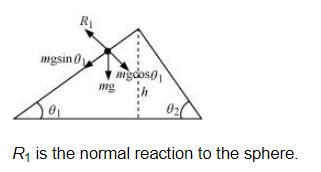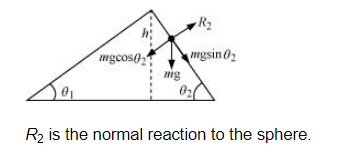A solid sphere rolls down two different inclined planes of the same heights but different angles of inclination.
A solid sphere rolls down two different inclined planes of the same heights but different angles of inclination.
(a) Will it reach the bottom with the same speed in each case?
(b) Will it take longer to roll down one plane than the other?
(c) If so, which one and why?
(a) Yes (b) Yes (c) On the smaller inclination
(a)Mass of the sphere = m
Height of the plane = h
Velocity of the sphere at the bottom of the plane = v
At the top of the plane, the total energy of the sphere = Potential energy = mgh
At the bottom of the plane, the sphere has both translational and rotational kinetic energies.
Hence, total energy $=\frac{1}{2} m v^{2}+\frac{1}{2} I \omega^{2}$
Using the law of conservation of energy, we can write:
$\frac{1}{2} m v^{2}+\frac{1}{2} I \omega^{2}=m g h$ $\ldots(i)$
For a solid sphere, the moment of inertia about its centre, $I=\frac{2}{5} m r^{2}$
Hence, equation (i) becomes:
$\frac{1}{2} m v^{2}+\frac{1}{2}\left(\frac{2}{5} m r^{2}\right) \omega^{2}=m g h$
$\frac{1}{2} v^{2}+\frac{1}{5} r^{2} \omega^{2}=\mathrm{g} h$
But we have the relation, $v=r \omega$
$\therefore \frac{1}{2} v^{2}+\frac{1}{5} v^{2}=\mathrm{g} / 2$
$v^{2}\left(\frac{7}{10}\right)=\mathrm{g} h$
$v=\sqrt{\frac{10}{7} \mathrm{~g} h}$
Hence, the velocity of the sphere at the bottom depends only on height (h) and acceleration due to gravity (g). Both these values are constants. Therefore, the velocity at the bottom remains the same from whichever inclined plane the sphere is rolled.
(b), (c)Consider two inclined planes with inclinations $\theta_{1}$ and $\theta_{2}$, related as:
$\theta_{1}<\theta_{2}$
The acceleration produced in the sphere when it rolls down the plane inclined at $\theta_{1}$ is:
$g \sin \theta_{1}$
The various forces acting on the sphere are shown in the following figure.

Similarly, the acceleration produced in the sphere when it rolls down the plane inclined at $\theta_{2}$ is:
$\mathrm{g} \sin \theta_{2}$
The various forces acting on the sphere are shown in the following figure.

$\theta_{2}>\theta_{1} ; \sin \theta_{2}>\sin \theta_{1} \ldots(i)$
$\therefore a_{2}>a_{1 \ldots}$ (ii)
Initial velocity, $u=0$
Final velocity, $v=$ Constant
Using the first equation of motion, we can obtain the time of roll as:
v = u + at
$\therefore t \propto \frac{1}{a}$

From equations (ii) and (iii), we get:
$t_{2}
Hence, the sphere will take a longer time to reach the bottom of the inclined plane having the smaller inclination.
Click here to get exam-ready with eSaral
For making your preparation journey smoother of JEE, NEET and Class 8 to 10, grab our app now.
